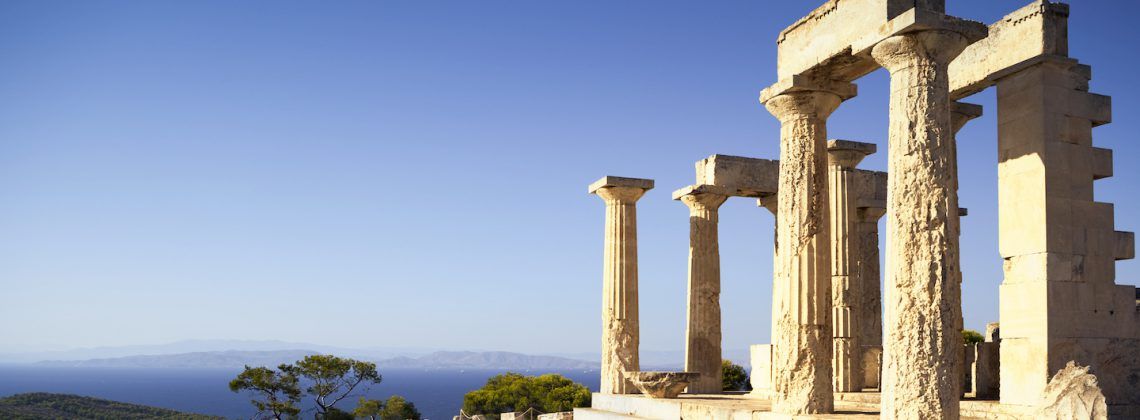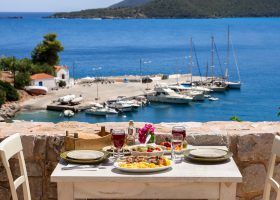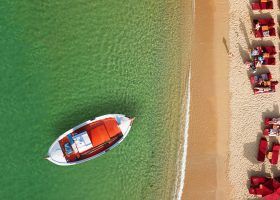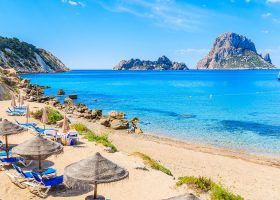Heading to the Greek Islands? Your knowledge of the Greek gods doesn’t go far beyond a Disney movie or a certain video game series? Fear not! Check out this crash course on the most famous Greek gods from mythology and associated with Greek Islands written by a historian!
Pro Tip: Planning what to do on your trip to Athens? Bookmark this post in your browser so you can easily find it when you’re in the city. Check out our guide to Athens for more planning resources, our top Athens tours for a memorable trip, and find out how to visit the Acropolis.
Famous Greek Gods & Goddesses and Where to Find Them Today
You have something in common with the Greek gods of mythology. No, it’s probably not superhuman powers. But like you, the Greek gods were huge fans of the Greek islands. In fact, according to myth, many gods call an island their birthplace. At the same time, others are said to have lived in one of Greece’s hundreds of islands. So, who are the famous gods, and why were they so important to Ancient Greeks?
For starters, Ancient Greeks looked to a host of gods and goddesses in all aspects of daily life. Archaeologists Christopher Mee and Anthony Spawforth tell us the main gods (called the Twelve Olympians) lived on Mount Olympus. From there, they held power to ensure harmony or havoc in Classical Greece. With all the love affairs, rivalries, and fights, the gods also produced enough drama to keep any reality tv show running for eternity.
Whether you’re planning an island-hopping trip or just here to live it up in Mykonos, plenty of ruins and artifacts connected to the Greek gods await discovery. And with that, let’s take a quick tour of Mount Olympus and the Greek islands favored by the gods.
13. Hephaestus of Lemnos
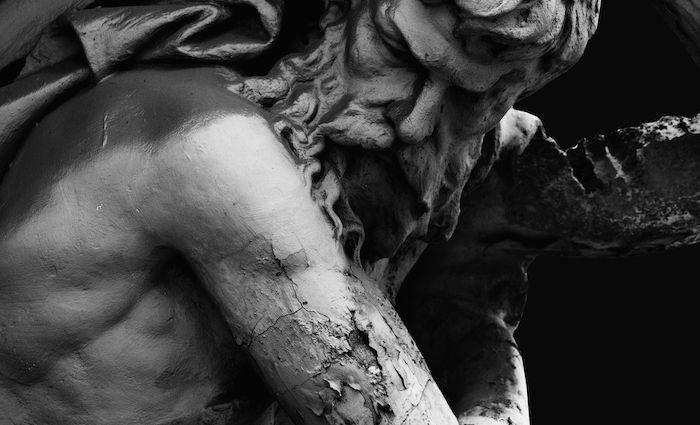
Son of Hera | Hardworking | Volcanoes
The god of fire, craftsmen, blacksmiths, and volcanoes, Hephaestus is widely described as a child of Hera alone. Mythology says because he was born crippled, Hera threw him out of the heavens. However, as scholar Michael Grant tells us, Hephaestus later received a warm welcome back on Mount Olympus after proving his mettle as a craftsman.
According to art historian Nigel McGilchrist, Hephaestus had a soft spot for the volcanic island of Lemnos (Limnos). Today you can visit the important archaeological site on the island, named Hephaestia. According to ancient historian Herodotus, the city of Hephaestia was inhabited by ancestors of the Greeks known as the Pelasgians. The ruins include an impressive Greek theater from the fifth or fourth centuries BCE.
12. Apollo of Delos, Mykonos
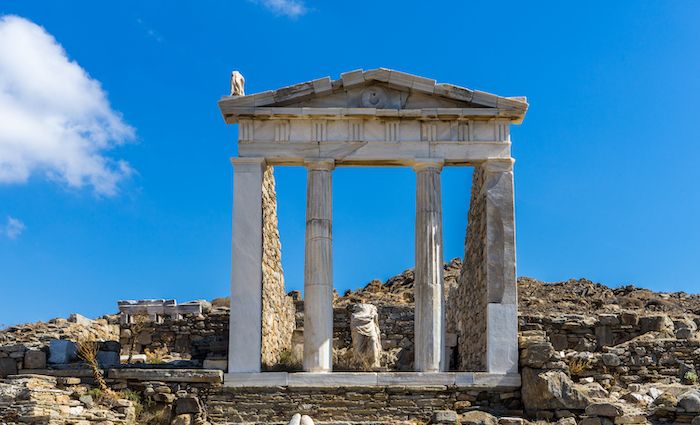
Son of Zeus | Popular | Patron of the Arts
Apollo certainly ranks as one of the more versatile of the Greek gods. He was at once the god of music, the arts, prophecy, and medicine. Apollo often appears as a youthful figure. Moreover, you’ll rarely see him in artistic renderings without a bow or lyre.
A beloved god among Ancient Greeks, Apollo had many temples and shrines dedicated in his honor. Without question, the most significant of these can still be visited today on the island of Delos. Delos is only reached via a brief ferry ride from neighboring Mykonos.
For historian David Abulafia, Apollo’s cult at Delos was the most influential religious cult in the Aegean. Indeed, at Delos, the Athenians seized on Greek city-state solidarity against the Persian Empire to forge the Delian League in 477 BCE. The league’s vast treasury was also based on the island for many years. However, the rise of Athens eventually set the course for war against (This is!) Sparta in the Peloponnesian War of 431-404 BCE.
Part sanctuary part ancient equivalent of the Federal Reserve, Delos is home to the great temple of Apollo. It also boasts the best-preserved residential quarter of Ancient Greece. Delos served as the symbolic heart of Ancient Greek shared identity. At the same time, Delos emerged as a thriving commercial port.
11. Asclepius of Kos
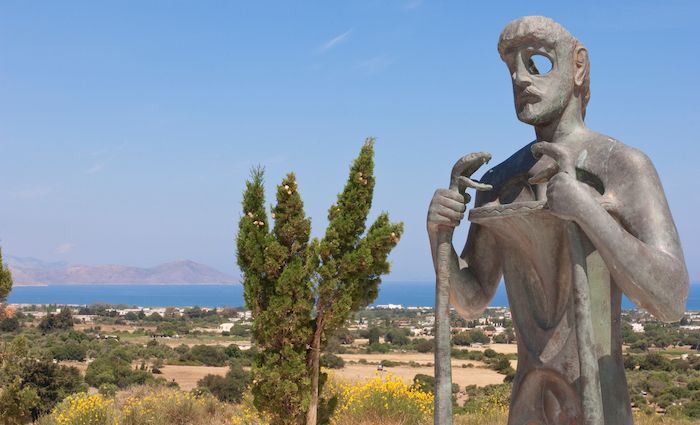
Son of Apollo | Healer | Part Mortal
Asclepius was the god of medicine. He was the son of Apollo and a mortal princess. Asclepius was renowned for his healing powers, which mirrored those of Apollo.
As you might expect, Asclepius was a sought-after deity during epidemics. The Greeks worshipped Asclepius at complexes called Asclepions. These were part sanctuary and part medical school. The most famous surviving example is the Asclepion in Kos.
Art historian Nigel McGilchrist tells us that the Asclepion complex of Kos was built on a rise of three terraces during the fourth century BCE. The first terrace included functional and hospital areas. The second terrace featured cult areas. Finally, the third terrace, added in the mid-second century BCE, was built to house a second temple to Asclepius.
The Asclepion is located just outside of Kos Town. From the upper terrace, you will have great views of the nearby Turkish coastline.
10. Dionysus of Naxos
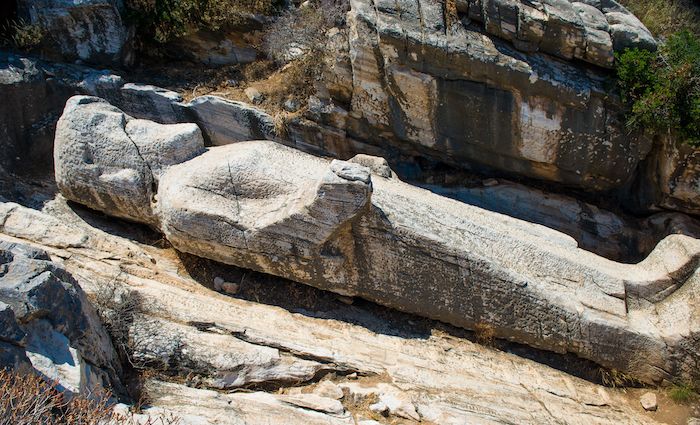
Son of Zeus | Vine & Wine | Partying
The life of the party on Mount Olympus. Dionysus was the god of wine, intoxication, revelry, frenzy, and madness. Portrayed as both young and old, Dionysus often bragged about being born from Zeus’ thigh. As you might expect from the god of good times, he is seldom depicted without a crowd of fellow partygoers. Thus, not surprisingly, Dionysus was one of the most beloved deities for Ancient Greeks.
Dionysus was especially popular on the island of Naxos. In fact, near the northern fishing village of Apollon, there is a colossal statue believed to depict Dionysus. Laying unfinished in a quarry where the artists left it over 2,000 years ago, this statue would have been the largest raised in all Classical Greece. According to scholar Nigel McGilchrist, the piece was likely to be placed at a sanctuary dedicated to Dionysus at Yria in western Naxos.
The Romans knew Dionysus as Bacchus. Whatever you want to call him, be sure to think of him the next time you raise a glass of vino.
9. Aphrodite of Kythera
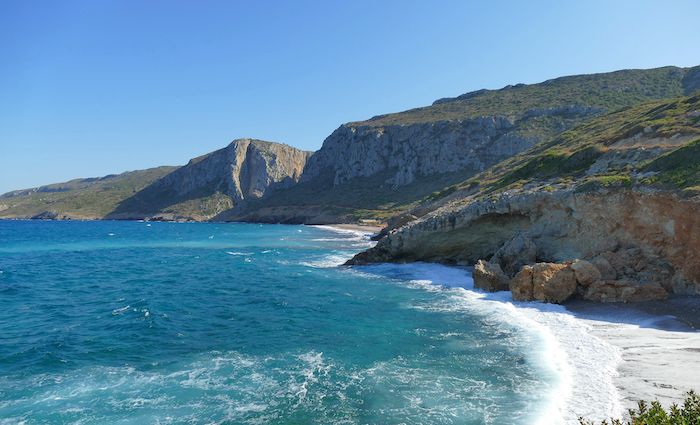
Temptress | Magic Girdle | Scallop Shell
The goddess of love and lust, Aphrodite’s beauty entranced gods and mortals alike. How did she captivate everyone she encountered? Why, with a magic girdle that could make anyone, mortal or immortal, fall in love with the person wearing it.
Alongside the magic girdle, Aphrodite’s other famous symbol is the scallop shell. Scholar Michael Grant reminds us that the scallop shell relates to the mythological story of her birth from sea foam. The Romans called Aphrodite Venus. So, you may recognize the scallop shell symbol and Venus from the famous Renaissance painting, The Birth of Venus, by Florentine artist Sandro Botticelli.
Aphrodite had a significant presence in Greek islands, partly because she offered protection for sailors against shipwrecks. As a result, there are many surviving ruins of sanctuaries dedicated to Aphrodite. Examples include Rhodes, Delos, and Kythera.
While her birthplace is primarily associated with the eastern Mediterranean island of Cyprus, the Greek island of Kythera also claims Aphrodite as a native. The ancient poet Hesiod supports the view that Aphrodite is from Kythera.
8. Hermes of Delos, Mykonos
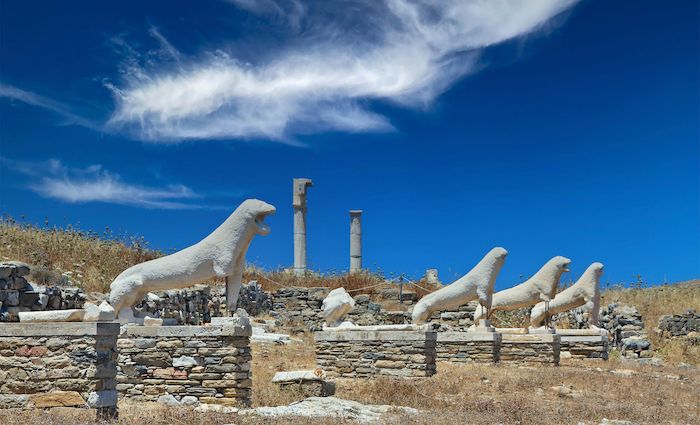
Messenger | Prankster | Winged Sandals
Hermes, the messenger god, is famed for his iconic winged sandals. Myths also suggest he was quite the trickster. For example, Hermes first got in trouble as a baby for messing with Apollo’s cattle.
Temples dedicated to various gods were everywhere in Ancient Greece. For instance, archaeologists Christopher Mee and Anthony Spawforth tell us that one second century CE observer counted 64 shrines in Sparta alone. Why were temples and shrines so common in Ancient Greece? Because for the Greeks, the gods were everywhere.
Despite the prevalence of temples and shrines to various deities, Hermes had few dedicated to him alone. Delos featured a rare exception because of Hermes’ popularity with merchants. Historian David Abulafia tells us that merchants formed an ancient guild system and built temples on Delos to their favored gods, including Hermes.
7. Homer of Ios
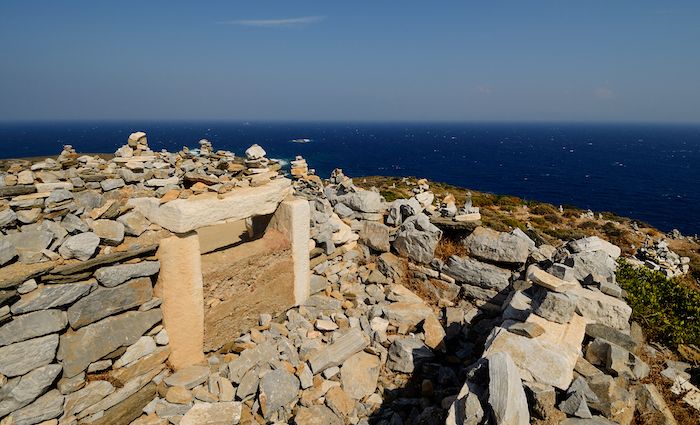
Poet | Storyteller | Adventurer
Although a mere mortal when it comes to the realm of gods and men, Homer certainly is immortal in the literary world. Despite his fame, we know very little about Homer. For centuries though, the credited poet behind the Iliad and the Odyssey has been associated with Ios.
One reason for the island’s connection to Homer is the uninhabited northern tip that some claim houses Homer’s tomb. Specifically, the Epano Kambos valley area has the remains of a Hellenistic watchtower and related structures. An eighteenth-century Dutch adventurer boasted that he found Homer’s tomb at this spot. However, it is doubtful the ruins in question date as far back as Homer’s alleged lifetime.
But as Nigel McGilchrist tells us, people have traveled here ever since to pay their respects to the dubious claim. The scenery framed by the deep blue waters of the Aegean ensures that you won’t feel cheated by venturing up to see Homer’s “so-called” tomb.
6. Artemis & Aphaia of Aegina
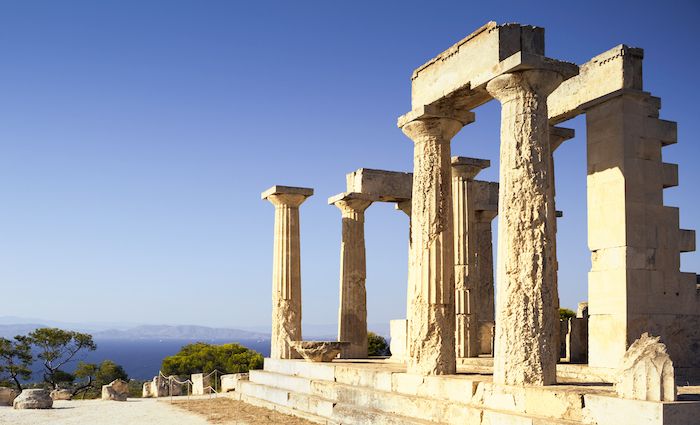
Nature | Hunting | Childbirth
Artemis was Apollo’s twin sister. The Ancient Greeks worshipped her as the goddess of childbirth. She also became known as the protector of animals. However, as scholar Michael Grant notes, two critical details make these distinctions unusual. Firstly, Artemis asked Zeus for and was granted eternal virginity. At the same time, Artemis loved hunting. Confused yet?
Unlike the other deities discussed here, the goddess Aphaia was worshipped in one specific place in Greece. And that place was the Saronic island of Aegina, located a short trip from Athens. Like Artemis, Aphaia appears to be associated with childbirth. According to archaeologist Eleni Papastavrou, the Temple of Aphaia in Aegina dates from the sixth century BCE.
5. Gods of the Underworld of Samothrace
Darkness | Mystery | Artistic Masterpiece
Ancient Greeks believed there were a host of gods of the underworld. Firstly, there’s the brother of Zeus and some of the other Twelve Olympians, Hades. Secondly, Persephone, Demeter’s daughter, joined Hades in the underworld as his consort. As the god of death, underworld gods like Hades did not have many devoted fans in Classical Greece.
On top of these gods, there were older spiritual figures of the underworld with foreign origins. According to archaeologist Dimitris Matsas, among these was a group of mysterious gods known as the Cabeiri. The Cabeiri were the focus of a large archaeological site on the island of Samothrace called the Sanctuary of the Great Gods.
The site’s main claim to fame is from a statue that once dominated one area. Today you can see a large base from which the Winged Victory of Samothrace was removed in 1863 to the Louvre in Paris. Pilgrims to the sanctuary in antiquity likely had little idea they were seeing not only one of the most famous pieces of art on display in the Louvre but in the world.
Macedonian ruler Demetrius I Poliorcetes likely commissioned the Winged Victory of Samothrace to commemorate a victory over Ptolemy II in 305 BCE. Similarly, the same leader’s epic defeat in a siege of the island of Rhodes produced the famous Colossus of Rhodes. Considering these points, British novelist and travel writer Lawrence Durrell expressed admiration at Demetrius’ impressive ability to connect battles to artistic masterpieces.
4. Poseidon of Poros
Brother of Zeus | Anger Issues | Trident
God of the sea and forces of nature, Poseidon frequently appears as an older bearded male. Constantly angry and jealous, Poseidon often sparred with other gods for control of dry land. For example, as historian Paul Cartledge explains, the most famous of these competitions was against Athena for Athens.
Notorious for his moods, Poseidon’s rage and mighty trident could trigger tidal waves, flooding, earthquakes, and volcanic eruptions. Moreover, historian David Abulafia reminds us that Odysseus became a sworn enemy of Poseidon’s in Homer’s the Odyssey. Subsequently, Poseidon harassed Odysseus and his crew after Odysseus killed his son Polyphemos the Cyclops.
Poros, one of the Saronic Islands near Athens and the Peloponnese, is home to the remains of a temple of Poseidon. This temple emerged as a place of refuge for political exiles from across the Greek world. Undoubtedly, the most famous of these exiles was the Athenian orator Demosthenes. On the run from his Macedonian opponents and out of options, art historian Nigel McGilchrist tells us Demosthenes took poison at this temple in 322 BCE.
After that, be sure to check out the impressive Temple of Poseidon at Cape Sounion outside Athens. Above all, don’t miss out on sunset at this spot.
3. Athena of Rhodes
Favorite Daughter of Zeus | Resourceful | Olive Tree
Few gods and goddesses held as much influence as Athena. As the goddess of wisdom, Athena was trusted as a close advisor to her father, Zeus. Ancient Greeks also sought her wise counsel on issues ranging from agricultural production to planning designed to stop foreign invasions.
In return, Athena dispensed valuable resources like the olive tree. As historian Paul Cartledge points out, this became an important story in the rise of Athens as a major power in the Greek world.
Athena also enjoyed the status of a fierce warrior. Christopher Mee and Anthony Spaworth tell us that many Greeks considered her the goddess of military strategy. Athena’s connection to military strategy is evident in the prevalence of temples dedicated to her in fortresses. The most famous example is unquestionably the Parthenon on the Acropolis in Athens. However, there are numerous temples dedicated to Athena scattered across the Aegean.
One example is the Temple of Athena Lindia at the Acropolis of Lindos in Rhodes. The ancient historian Herodotus says that the temple was founded by the mythological Danaids as far back as 700 BCE. According to Nigel McGilchrist, the temple had a statue modeled on the famous Athena Parthenos from the Parthenon by the fifth or fourth century BCE.
2. Hera of Samos & Corfu
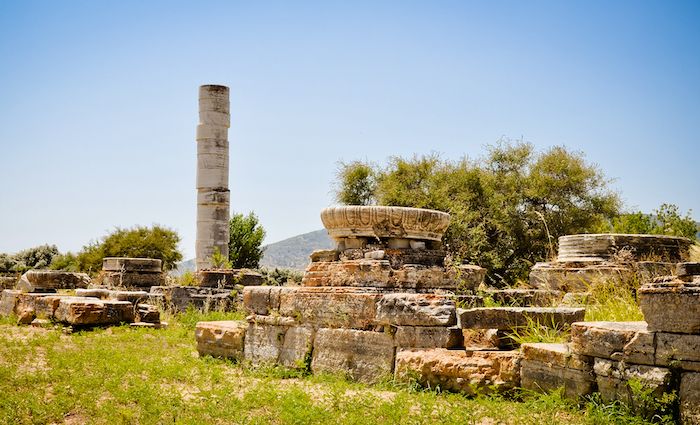
Wife & Sister of Zeus | Matron | Queen of the Gods
A sister of Zeus and later his wife, Hera held the status of Queen of the Gods. She was mother to Ares (the god of war), Hephaestus (the god of fire), and Hebe (the goddess of youth). Furthermore, Ancient Greeks worshipped her as the goddess of marriage. As scholar Fritz Lang tells us, Hera hailed from the island of Samos.
As a result, the Samians built a colossal temple dedicated to Hera. Called the Heraion, the ancient historian Herodotus believed the temple was the largest in Greece. According to archaeologist Maria Viglaki-Sofianou, the temple’s construction dates to 538-522 BCE. Unfortunately, only a lone column remains today as part of a sprawling archaeological site.
Another temple dedicated to Hera with visible remains is in Corfu. It is located on the grounds of the villa Mon Repos. Located a short bus ride outside Corfu Town, the villa was the birthplace in 1921 of Prince Philip, the Duke of Edinburgh. The prince, of course, is better known as the late husband of Britain’s Queen Elizabeth II. A section of the public grounds surrounding Mon Repos includes the ancient ruins of Paleopolis and the temple of Hera.
1. Zeus of Crete
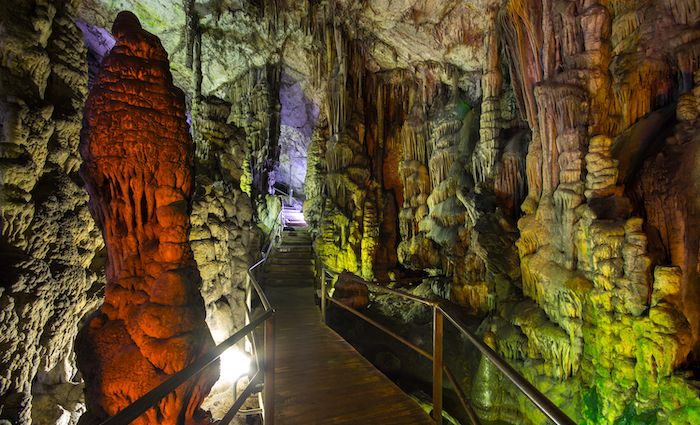
Lord of the Heavens | Lawgiver | Thunderbolt
You might know him as the head honcho of the Twelve Olympian gods. Indeed, Zeus was king of the gods and the overseer of law and order, which he often dealt out with a thunderbolt. However, even a mighty Olympian like Zeus was once a baby. Zeus nearly did not survive because of his father’s paranoia.
The Greek poet Hesiod relates the story to us. Cronos (Time), the Titan father of many Olympian gods like Zeus, believed his child could one day depose him as ruler. As a result, Cronos swallowed a host of would-be gods and goddesses, including several of Zeus’ siblings.
As writer Lawrence Durrell notes, Zeus overthrew Cronos and the Titans, saving his siblings, including Poseidon, Hera, and Hestia. Afterward, Zeus formed the Olympian gods into a general committee to oversee affairs on earth. So, who do we have to thank for saving Zeus from Cronos in the first place?
That would be the island of Crete. Indeed, the island embraced Zeus, who was hidden deep in the earth by his mother, Rhea. Today you can explore the Diktaean Cave in eastern Crete and the Idaian Cave in the western part of the island. As Hesiod tells us, both caves sheltered Zeus and became a playground for the future king of the gods.
Hopefully, this crash course helps bring the gods to life. Finally, when you’re on the ground in Greece, you can learn more by visiting any town or city’s archaeological museum.
